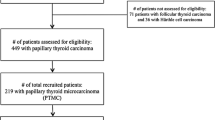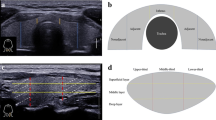Abstract
Peripheral localisation of papillary thyroid microcarcinoma (PTMC), in comparison with intraparenchymal PTMC (i-PTMC) is related to some clinicopathological features related with biological aggressiveness, including lymph node metastasis (LNM). The expression of PD-L1 in tumour cell has been associated with increased tumour survival, progression, and potentially an aggressive clinical course. This study evaluates the relation between clinicopathological features of PTMC, including tumour localisation, with PD-L1 immunoexpression. The study included 99 patients with the histological diagnosis of PTMC (≥ 5 mm). PD-L1 protein expression was assessed by immunohistochemistry. PTMCs were divided into the four following groups: G1– peripherally localised PTMC (p-PTMC) with PD-L1 expression; G2–p-PTMC without PD-L1 expression; G3–i-PTMC with PD-L1 expression and G4–i-PTMC without PD-L1 expression. G1 was the most frequent (n = 46; 46.5%), followed by G4 (n = 25; 25.3%) and similar distribution of G3 (n = 15; 15.2%) and G2 (n = 13; 13.1%). In comparison with other groups, G1 was significantly associated with classical morphology, invasive growth, lymphatic invasion (LI), vascular invasion (VI), psammoma bodies, intratumoral fibrosis, PD-L1 positive tumour-infiltrating lymphocytes, and multinuclear giant cells (MGCs). G4 more commonly exhibited follicular morphology, expansive/circumscribed growth, and absence of the following: intratumoural fibrosis, LI, VI, psammoma bodies, PD-L1 positive tumour-infiltrating lymphocytes, and MGCs. LNMs were significantly more frequent in G1 in comparison with the other groups (p = 0.000). In conclusion, morphology and tumour microenvironment of p-PTMC with PD-L1 expression is different from i-PTMC without PD-L1 expression. The differences between these two groups of PTMC include clinicopathological features related with biological aggressiveness such as the occurrence of LNM.

Similar content being viewed by others
Data Availability
The data set generated and/or analyzed during the current study are available from the corresponding author.
References
Lloyd RV, Osamura RY, Klöpel G, Rosai J, editors. World Health Organization classification of tumours of endocrine organs. Lyon: IARC Press; 2017.
Soares P, Celestino R, da Rocha AG, Sobrinho-Simões M. Papillary thyroid microcarcinoma: how to diagnose and manage this epidemic? Int J Surg Pathol. 2014;22(2):113–9. https://doi.org/10.1177/1066896913517394.
Noguchi S, Yamashita H, Uchino S, Watanabe S. Papillary microcarcinoma. World J Surg. 2008;32(5):747–53. https://doi.org/10.1007/s00268-007-9453-0.
Roti E, degli-Uberti EC, Bondanelli M, Braverman LE. Thyroid papillary microcarcinoma: a descriptive and meta-analysis study. Eur J Endocrinol. 2008;159(6):659–73. https://doi.org/10.1530/EJE-07-0896.
Hay ID, Hutchinson ME, Gonzalez-Losada T, McIver B, Reinalda ME, Grant CS et al. Papillary thyroid microcarcinoma: a study of 900 cases observed in a 60-year period. Surgery. 2008;144(6):980–7; discussion 987–8. doi: https://doi.org/10.1016/j.surg.2008.08.035.
Wada N, Duh QY, Sugino K, Iwasaki H, Kameyama K, Mimura T, et al. Lymph node metastasis from 259 papillary thyroid microcarcinomas: frequency, pattern of occurrence and recurrence, and optimal strategy for neck dissection. Ann Surg. 2003;237(3):399–407. https://doi.org/10.1097/01.SLA.0000055273.58908.19.
DeLellis RA, Lloyd RV, Heitz PU, Eng C. World Health Organization classification of tumors. Pathology and genetics of tumors of endocrine organs. Lyon: IARC Press; 2004.
Niemeier LA, Kuffner Akatsu H, Song C, Carty SE, Hodak SP, Yip L, et al. A combined molecular-pathologic score improves risk stratification of thyroid papillary microcarcinoma. Cancer. 2012; 118: 2069–2077; 4: 2185. doi: https://doi.org/10.1002/cncr.26425.
Virk RK, Van Dyke AL, Finkelstein A, Prasad A, Gibson J, Hui P, et al. BRAFV600E mutation in papillary thyroid microcarcinoma: a genotype-phenotype correlation. Mod Pathol. 2013;26(1):62–70. https://doi.org/10.1038/modpathol.2012.152.
Ciobanu Apostol D, Giuşcă SE, Căruntu ID, Lozneanu L, Andriescu EC, Moscalu M. Relationships between clinicopathological prognostic factors in papillary thyroid microcarcinoma: a refined analysis based on 428 cases. Int J Clin Exp Pathol. 2017;10(8):8944–56.
Tallini G, De Leo A, Repaci A, de Biase D, Bacchi Reggiani ML, Di Nanni D, et al. Does the site of origin of the microcarcinoma with respect to the thyroid surface matter? A multicenter pathologic and clinical study for risk stratification. Cancers (Basel). 2020;12(1):246. https://doi.org/10.3390/cancers12010246.
Collins M, Ling V, Carreno BM. The B7 family of immune-regulatory ligands. Genome Biol. 2005;6(6):223. https://doi.org/10.1186/gb-2005-6-6-223.
Guan J, Lim KS, Mekhail T, Chang CC. Programmed death ligand-1 (PD-L1) expression in the programmed death receptor-1 (PD-1)/PD-L1 blockade: a key player against various cancers. Arch Pathol Lab Med. 2017;141(6):851–61. https://doi.org/10.5858/arpa.2016-0361-RA.
Sun C, Mezzadra R, Schumacher TN. Regulation and function of the PD-L1 checkpoint. Immunity. 2018;48(3):434–52. https://doi.org/10.1016/j.immuni.2018.03.014.
Chen L, Han X. Anti-PD-1/PD-L1 therapy of human cancer: past, present, and future. J Clin Invest. 2015;125(9):3384–91. https://doi.org/10.1172/JCI80011.
Ahn S, Kim TH, Kim SW, Ki CS, Jang HW, Kim JS, Kim JH, Choe JH, Shin JH, Hahn SY, Oh YL, Chung JH. Comprehensive screening for PD-L1 expression in thyroid cancer. Endocr Relat Cancer. 2017;24(2):97–106. https://doi.org/10.1530/ERC-16-0421.
Cunha LL, Marcello MA, Morari EC, Nonogaki S, Conte FF, Gerhard R, Soares FA, Vassallo J, Ward LS. Differentiated thyroid carcinomas may elude the immune system by B7H1 upregulation. Endocr Relat Cancer. 2013;20(1):103–10. https://doi.org/10.1530/ERC-12-0313.
Aghajani M, Graham S, McCafferty C, Shaheed CA, Roberts T, DeSouza P, et al. Clinicopathologic and prognostic significance of programmed cell death ligand 1 expression in patients with non-medullary thyroid cancer: A systematic review and meta-analysis. Thyroid. 2018;28(3):349–361. https://doi.org/10.1089/thy.2017.0441.
Girolami I, Pantanowitz L, Mete O, Brunelli M, Marletta S, Colato C, et al. Programmed death-ligand 1 (PD-L1) is a potential biomarker of disease-free survival in papillary thyroid carcinoma: a systematic review and meta-analysis of PD-L1 immunoexpression in follicular epithelial derived thyroid carcinoma. Endocr Pathol. 2020;31(3):291–300. https://doi.org/10.1007/s12022-020-09630-5.
Chowdhury S, Veyhl J, Jessa F, Polyakova O, Alenzi A, MacMillan C, et al. Programmed death-ligand 1 overexpression is a prognostic marker for aggressive papillary thyroid cancer and its variants. Oncotarget. 2016;7(22):32318–28. https://doi.org/10.18632/oncotarget.8698.
Aghajani MJ, Yang T, McCafferty CE, Graham S, Wu X, Niles N. Predictive relevance of programmed cell death protein 1 and tumor-infiltrating lymphocyte expression in papillary thyroid cancer. Surgery. 2018;163(1):130–6. https://doi.org/10.1016/j.surg.2017.04.033.
Lubin D, Baraban E, Lisby A, Jalali-Farahani S, Zhang P, Livolsi V. Papillary thyroid carcinoma emerging from hashimoto thyroiditis demonstrates increased PD-L1 expression, which persists with metastasis. Endocr Pathol. 2018;29(4):317–23. https://doi.org/10.1007/s12022-018-9540-9.
Amin MB, Edge S, Greene FL, Schilsky RL, Byrd DR, Gaspar LE, Washington MK, Gershenwald JE, Compton CC, Hess KR, editors. AJCC cancer staging manual. 8th ed. Cham, Switzerland: Springer International Publishing AG; 2016.
Cheng SP, Lee JJ, Chien MN, Kuo CY, Jhuang JY, Liu CL. Lymphovascular invasion of papillary thyroid carcinoma revisited in the era of active surveillance. Eur J Surg Oncol. 2020;46(10 Pt A):1814–9. https://doi.org/10.1016/j.ejso.2020.06.044.
Mete O, Asa SL. Pathological definition and clinical significance of vascular invasion in thyroid carcinomas of follicular epithelial derivation. Mod Pathol. 2011;24(12):1545–52. https://doi.org/10.1038/modpathol.2011.119.
Bai Y, Zhou G, Nakamura M, Ozaki T, Mori I, Taniguchi E, et al. Survival impact of psammoma body, stromal calcification, and bone formation in papillary thyroid carcinoma. Mod Pathol. 2009;22(7):887–94. https://doi.org/10.1038/modpathol.2009.38.
Bai Y, Niu D, Huang X, Jia L, Kang Q, Dou F, et al. PD-L1 and PD-1 expression are correlated with distinctive clinicopathological features in papillary thyroid carcinoma. Diagn Pathol. 2017;12(1):72. https://doi.org/10.1186/s13000-017-0662-z.
Brooks E, Simmons-Arnold L, Naud S, Evans MF, Elhosseiny A. Multinucleated giant cells’ incidence, immune markers, and significance: a study of 172 cases of papillary thyroid carcinoma. Head Neck Pathol. 2009;3(2):95–9. https://doi.org/10.1007/s12105-009-0110-9.
Mizukami Y, Michigishi T, Kawato M, Sato T, Nonomura A, Hashimoto T, Matsubara F. Chronic thyroiditis: thyroid function and histologic correlations in 601 cases. Hum Pathol. 1992;23(9):980–8. https://doi.org/10.1016/0046-8177(92)90258-5.
Bastman JJ, Serracino HS, Zhu Y, Koenig MR, Mateescu V, Sams SB, et al. Tumor-infiltrating T cells and the PD-1 checkpoint pathway in advanced differentiated and anaplastic thyroid cancer. J Clin Endocrinol Metab. 2016;101(7):2863–73. https://doi.org/10.1210/jc.2015-4227.
Katoh R, Sasaki J, Kurihara H, Suzuki K, Iida Y, Kawaoi A. Multiple thyroid involvement (intraglandular metastasis) in papillary thyroid carcinoma. A clinicopathologic study of 105 consecutive patients. Cancer. 1992;70(6):1585–90.
Russl WO, Ibanez ML, Clark RL, White EC. Thyroid carcinoma. Classification, intraglandular dissemination, and clinicopathological study based upon whole organ sections of 80 glands. Cancer. 1963;16:1425–60.
Koperek O, Asari R, Niederle B, Kaserer K. Desmoplastic stromal reaction in papillary thyroid microcarcinoma. Histopathology. 2011;58(6):919–24. https://doi.org/10.1111/j.1365-2559.2011.03791.x.
Kim BY, Jung CH, Kim JW, Lee SW, Kim CH, Kang SK, et al. Impact of clinicopathologic factors on subclinical central lymph node metastasis in papillary thyroid microcarcinoma. Yonsei Med J. 2012;53(5):924–30. https://doi.org/10.3349/ymj.2012.53.5.924.
Lim YC, Choi EC, Yoon YH, Kim EH, Koo BS. Central lymph node metastases in unilateral papillary thyroid microcarcinoma. Br J Surg. 2009;96(3):253–7. https://doi.org/10.1002/bjs.6484.
Lee E, Jung W, Woo JS, Lee JB, Shin BK, Kim HK, et al. Tumor sprouting in papillary thyroid carcinoma is correlated with lymph node metastasis and recurrence. Korean J Pathol. 2014;48(2):117–25. https://doi.org/10.4132/KoreanJPathol.2014.48.2.117.
Wagner K, Abraham E, Tran B, Roshan D, Wykes J, Campbell P, Ebrahimi A. Lymphovascular invasion and risk of recurrence in papillary thyroid carcinoma. ANZ J Surg. 2020;90(9):1727–32. https://doi.org/10.1111/ans.16202.
Ghossein R, Barletta J, Bullock M, Johnson S, Kakudo K, Lam A, et al. Carcinoma of the thyroid histopathology reporting guide. Sydney, Australia: International Collaboration on Cancer Reporting; 2019.
Tallini G, de Biase D, Durante C, Acquaviva G, Bisceglia M, Bruno R, et al. BRAF V600E and risk stratification of thyroid microcarcinoma: a multicenter pathological and clinical study. Mod Pathol. 2015;28(10):1343–59.
Bai Y, Guo T, Huang X, Wu Q, Niu D, Ji X, Feng Q, Li Z, Kakudo K. In papillary thyroid carcinoma, expression by immunohistochemistry of BRAF V600E, PD-L1, and PD-1 is closely related. Virchows Arch. 2018;472(5):779–87. https://doi.org/10.1007/s00428-018-2357-6.
Fu G, Polyakova O, MacMillan C, Ralhan R, Walfish PG. Programmed death - ligand 1 expression distinguishes invasive encapsulated follicular variant of papillary thyroid carcinoma from noninvasive follicular thyroid neoplasm with papillary-like nuclear features. EBioMedicine. 2017;18:50–5. https://doi.org/10.1016/j.ebiom.2017.03.031.
Shi RL, Qu N, Luo TX, Xiang J, Liao T, Sun GH, et al. Programmed death-ligand 1 expression in papillary thyroid cancer and its correlation with clinicopathologic factors and recurrence. Thyroid. 2017;27(4):537–45. https://doi.org/10.1089/thy.2016.0228.
Angell TE, Lechner MG, Jang JK, Correa AJ, LoPresti JS, Epstein AL. BRAF V600E in papillary thyroid carcinoma is associated with increased programmed death ligand 1 expression and suppressive immune cell infiltration. Thyroid. 2014;24(9):1385–93. https://doi.org/10.1089/thy.2014.0134.
Ulisse S, Tuccilli C, Sorrenti S, Antonelli A, Fallahi P, D’Armiento E, et al. PD-1 ligand expression in epithelial thyroid cancers: potential clinical implications. Int J Mol Sci. 2019;20(6):1405. https://doi.org/10.3390/ijms20061405.
Gibbons Johnson RM, Dong H. Functional expression of programmed death-ligand 1 (B7–H1) by immune cells and tumor cells. Front Immunol. 2017;8:961. https://doi.org/10.3389/fimmu.2017.00961.
Gulubova MV, Ivanova KV. The expression of tumor-associated macrophages and multinucleated giant cells in papillary thyroid carcinoma. Open Access Maced J Med Sci. 2019;7(23):3944–9. https://doi.org/10.3889/oamjms.
Sahai E, Astsaturov I, Cukierman E, DeNardo DG, Egeblad M, Evans RM, et al. A framework for advancing our understanding of cancer-associated fibroblasts. Nat Rev Cancer. 2020;20(3):174–86. https://doi.org/10.1038/s41568-019-0238-1.
Liu X, Zhang S, Gang Q, Shen S, Zhang J, Lun Y, et al. Interstitial fibrosis in papillary thyroid microcarcinoma and its association with biological behavior. Oncol Lett. 2018;15(4):4937–43. https://doi.org/10.3892/ol.2018.7928.
Inoue C, Miki Y, Saito R, Hata S, Abe J, Sato I, et al. PD-L1 induction by cancer-associated fibroblast-derived factors in lung adenocarcinoma cells. Cancers (Basel). 2019;11(9):1257. https://doi.org/10.3390/cancers11091257.
Funding
The authors did not receive support from any organization for the submitted work.
Author information
Authors and Affiliations
Contributions
BK, DV, and SC contributed to the study conception and design. Material preparation, data collection and analysis were performed by BK, and SC. The first draft of the manuscript was written by BK and all authors commented on previous versions of the manuscript. The scientific editing and final revision of the manuscript were performed by CE. All authors read and approved the final manuscript.
Corresponding author
Ethics declarations
Conflict of interest
The authors declare no potential conflicts of interest with respect to research, authorship, and/or publication of this article.
Ethics Approval
This work was performed in archived paraffin tissue that remained from the diagnosis of the thyroid samples of patients that were anonymized. The materials used for the work are not needed for diagnosis in the present nor in the future. The Ethics Committee of the Military Medical Academy and University of Defence, Serbia, approved this study (Number: 16–71; 5/29/2019).
Additional information
Publisher's Note
Springer Nature remains neutral with regard to jurisdictional claims in published maps and institutional affiliations.
Rights and permissions
About this article
Cite this article
Kovacevic, B., Vucevic, D., Cerovic, S. et al. Peripheral Versus Intraparenchymal Papillary Thyroid Microcarcinoma: Different Morphologies and PD-L1 Expression. Head and Neck Pathol 16, 200–212 (2022). https://doi.org/10.1007/s12105-021-01337-1
Received:
Accepted:
Published:
Issue Date:
DOI: https://doi.org/10.1007/s12105-021-01337-1




